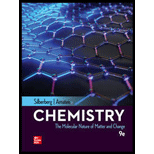
(a)
Interpretation:
The element and its condensed ground state electronic configuration with excited state electronic configuration
Concept introduction:
The electronic configuration tells about the distribution of electrons in various atomic orbital. The condensed electronic configuration is a way to write the electronic configuration where the inner shell configurations are compressed to the nearest noble gas configuration and only the valence shell configuration is written in the expanded form.
The lower stable energy level is known as the ground state whereas the higher unstable energy level is called the excited state. Elements in the excited state have much tendency to lose energy and come back to the ground state.
(b)
Interpretation:
The element and its condensed ground state electronic configuration with excited state electronic configuration
Concept introduction:
The electronic configuration tells about the distribution of electrons in various atomic orbital. The condensed electronic configuration is a way to write the electronic configuration where the inner shell configurations are compressed to the nearest noble gas configuration and only the valence shell configuration is written in the expanded form.
The lower stable energy level is known as the ground state whereas the higher unstable energy level is called the excited state. Elements in the excited state have much tendency to lose energy and come back to the ground state.
(c)
Interpretation:
The element and its condensed ground state electronic configuration with excited state electronic configuration
Concept introduction:
The electronic configuration tells about the distribution of electrons in various atomic orbital. The condensed electronic configuration is a way to write the electronic configuration where the inner shell configurations are compressed to the nearest noble gas configuration and only the valence shell configuration is written in the expanded form.
The lower stable energy level is known as the ground state whereas the higher unstable energy level is called the excited state. Elements in the excited state have much tendency to lose energy and come back to the ground state.
(d)
Interpretation:
The element and its condensed ground state electronic configuration with excited state electronic configuration
Concept introduction:
The electronic configuration tells about the distribution of electrons in various atomic orbital. The condensed electronic configuration is a way to write the electronic configuration where the inner shell configurations are compressed to the nearest noble gas configuration and only the valence shell configuration is written in the expanded form.
The lower stable energy level is known as the ground state whereas the higher unstable energy level is called the excited state. Elements in the excited state have much tendency to lose energy and come back to the ground state.
Want to see the full answer?
Check out a sample textbook solution
Chapter 8 Solutions
Chemistry: The Molecular Nature of Matter and Change
- Briefly explain chemical potential.arrow_forwardReason whether it is possible to determine changes in the Galvani potential difference at the metal-solution interface.arrow_forwardObtain the standard potential at 25°C of the Cu* I Cu | Pt electrode from the standard potentials E° Cu²+/Cu = 0.341 V and E Cu²+ /Cu+ = 0.153 V.arrow_forward
 ChemistryChemistryISBN:9781305957404Author:Steven S. Zumdahl, Susan A. Zumdahl, Donald J. DeCostePublisher:Cengage Learning
ChemistryChemistryISBN:9781305957404Author:Steven S. Zumdahl, Susan A. Zumdahl, Donald J. DeCostePublisher:Cengage Learning ChemistryChemistryISBN:9781259911156Author:Raymond Chang Dr., Jason Overby ProfessorPublisher:McGraw-Hill Education
ChemistryChemistryISBN:9781259911156Author:Raymond Chang Dr., Jason Overby ProfessorPublisher:McGraw-Hill Education Principles of Instrumental AnalysisChemistryISBN:9781305577213Author:Douglas A. Skoog, F. James Holler, Stanley R. CrouchPublisher:Cengage Learning
Principles of Instrumental AnalysisChemistryISBN:9781305577213Author:Douglas A. Skoog, F. James Holler, Stanley R. CrouchPublisher:Cengage Learning Organic ChemistryChemistryISBN:9780078021558Author:Janice Gorzynski Smith Dr.Publisher:McGraw-Hill Education
Organic ChemistryChemistryISBN:9780078021558Author:Janice Gorzynski Smith Dr.Publisher:McGraw-Hill Education Chemistry: Principles and ReactionsChemistryISBN:9781305079373Author:William L. Masterton, Cecile N. HurleyPublisher:Cengage Learning
Chemistry: Principles and ReactionsChemistryISBN:9781305079373Author:William L. Masterton, Cecile N. HurleyPublisher:Cengage Learning Elementary Principles of Chemical Processes, Bind...ChemistryISBN:9781118431221Author:Richard M. Felder, Ronald W. Rousseau, Lisa G. BullardPublisher:WILEY
Elementary Principles of Chemical Processes, Bind...ChemistryISBN:9781118431221Author:Richard M. Felder, Ronald W. Rousseau, Lisa G. BullardPublisher:WILEY





